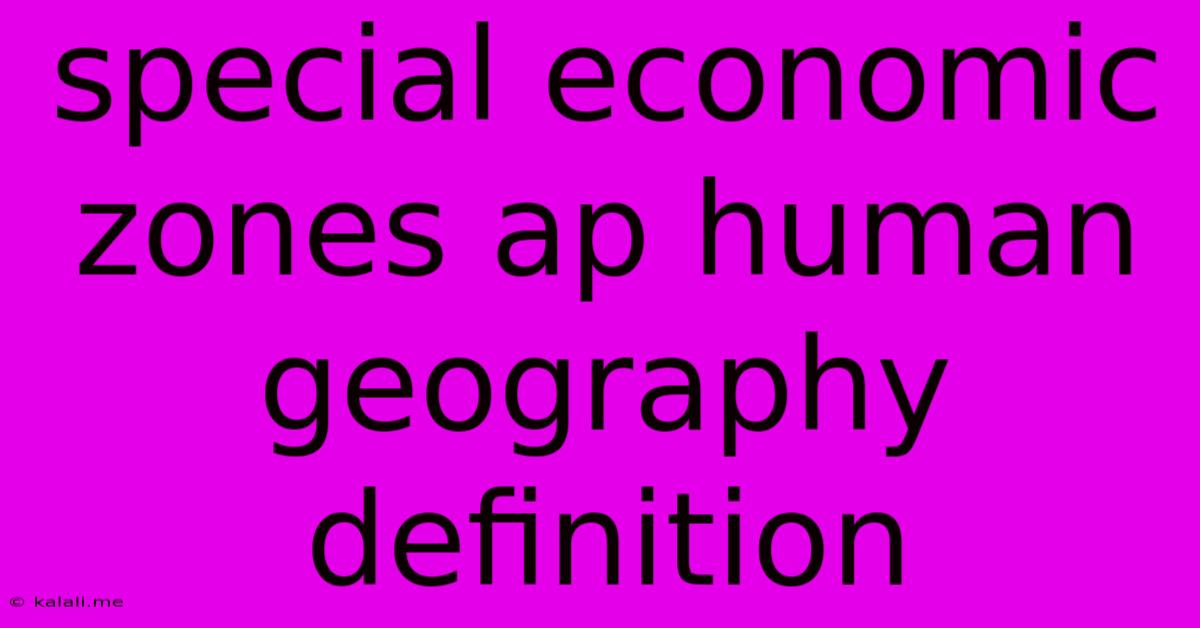Special Economic Zones Ap Human Geography Definition
Kalali
Jun 15, 2025 · 3 min read

Table of Contents
Special Economic Zones (SEZs): A Deep Dive into Their Definition and Significance in AP Human Geography
Meta Description: Understand Special Economic Zones (SEZs) in AP Human Geography. This article defines SEZs, explores their characteristics, impact on economic development, and provides real-world examples.
Special Economic Zones (SEZs) are a crucial topic in AP Human Geography, representing a significant aspect of globalization and economic development strategies. Understanding their definition, characteristics, and impact is vital for success in the course and beyond. This article will provide a comprehensive overview of SEZs, exploring their role in shaping global economies.
Defining Special Economic Zones
A Special Economic Zone (SEZ) is a geographically designated area within a country that operates under different economic regulations than the rest of the country. These regulations are typically designed to attract foreign and domestic investment by offering incentives such as tax breaks, simplified customs procedures, relaxed labor laws, and streamlined bureaucracy. The aim is to stimulate economic growth, increase employment opportunities, and boost exports within the designated zone.
Key Characteristics of SEZs
Several key features commonly define SEZs:
- Tax Incentives: Reduced or eliminated corporate taxes, import/export duties, and other levies are significant attractors for businesses.
- Simplified Regulations: Easier business registration processes, fewer bureaucratic hurdles, and streamlined permitting procedures reduce operational costs and complexities.
- Infrastructure Development: SEZs often benefit from improved infrastructure, including transportation networks (roads, ports, airports), utilities (water, electricity), and communication systems.
- Foreign Investment Incentives: Policies designed to specifically attract foreign direct investment (FDI), including incentives for technology transfer and joint ventures.
- Export-Oriented Focus: Many SEZs prioritize industries geared towards exports, contributing to a nation's balance of trade.
- Specialized Labor: While labor laws may be relaxed in some instances, SEZs often attract a skilled workforce due to the opportunities presented.
The Impact of SEZs on Economic Development
The impact of SEZs on economic development can be both positive and negative. Positive impacts often include:
- Increased Foreign Direct Investment (FDI): Attracting significant capital inflows from multinational corporations.
- Job Creation: Generating employment opportunities, particularly in manufacturing and export-oriented industries.
- Technological Advancement: Facilitating technology transfer and the adoption of advanced production techniques.
- Regional Development: Stimulating economic growth in underdeveloped or less-developed regions.
- Export Growth: Boosting a nation's exports and improving its balance of trade.
However, potential negative impacts should also be considered:
- Environmental Concerns: Rapid industrialization can lead to environmental degradation and pollution if not properly managed.
- Social Inequality: Benefits might not be evenly distributed, leading to disparities in income and living standards.
- Labor Exploitation: Relaxed labor laws can potentially lead to exploitation of workers if not carefully monitored.
- Dependence on Foreign Investment: Over-reliance on FDI can make the economy vulnerable to global economic fluctuations.
- Regional Disparities: While intended to boost regional development, SEZs may inadvertently exacerbate existing regional inequalities if not carefully planned.
Real-World Examples of SEZs
Numerous countries have implemented SEZs with varying degrees of success. Examples include:
- Shenzhen, China: A prime example of a highly successful SEZ that transformed from a small fishing village into a major technological and manufacturing hub.
- Export Processing Zones (EPZs) in Bangladesh: These zones have played a significant role in the country's garment industry.
- Special Economic Zones in India: India has established numerous SEZs aimed at attracting investment and boosting its manufacturing sector.
Conclusion
Special Economic Zones represent a complex tool in the arsenal of economic development strategies. While they can significantly contribute to economic growth, job creation, and technological advancement, careful planning and regulation are essential to mitigate potential negative consequences and ensure equitable distribution of benefits. Understanding their characteristics and impacts is crucial for comprehending contemporary globalization and its effects on the world's economies, making them an important subject within AP Human Geography.
Latest Posts
Latest Posts
-
Is A Snake A Tertiary Consumer
Jun 15, 2025
-
How To Change The Sat Test Date
Jun 15, 2025
-
A Is The Brother Of B
Jun 15, 2025
-
Reaction Of Iron And Hydrochloric Acid
Jun 15, 2025
-
Fcc Unit Cell Number Of Atoms
Jun 15, 2025
Related Post
Thank you for visiting our website which covers about Special Economic Zones Ap Human Geography Definition . We hope the information provided has been useful to you. Feel free to contact us if you have any questions or need further assistance. See you next time and don't miss to bookmark.